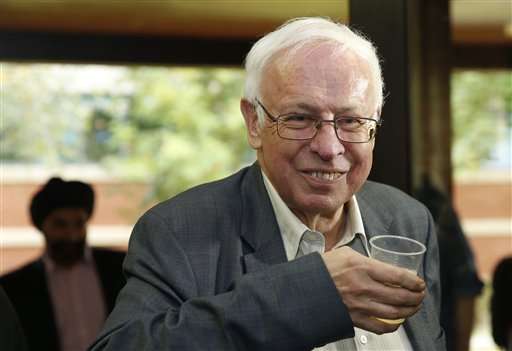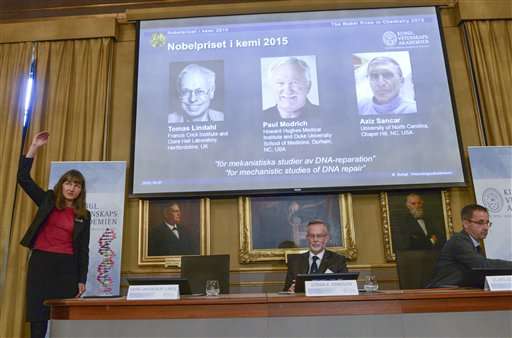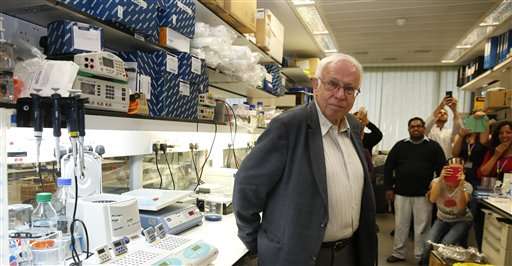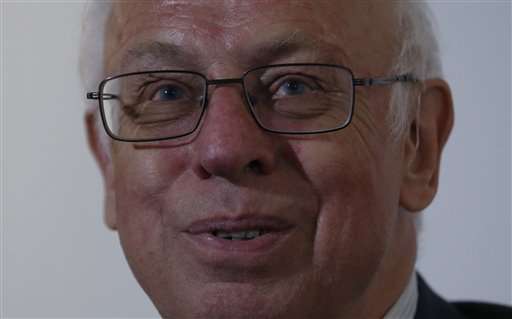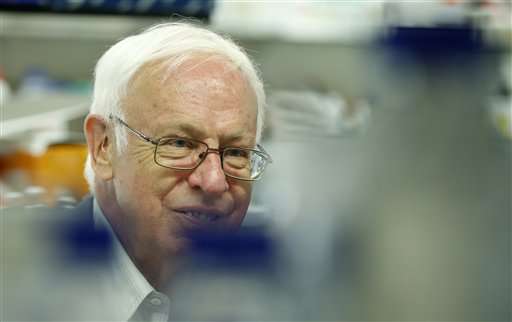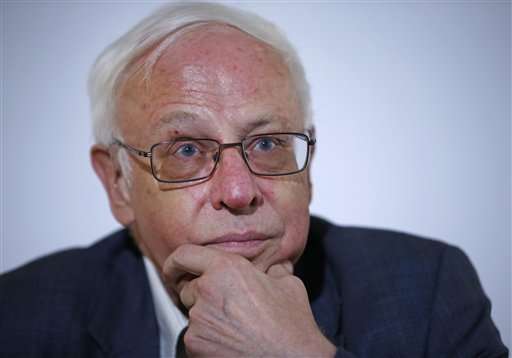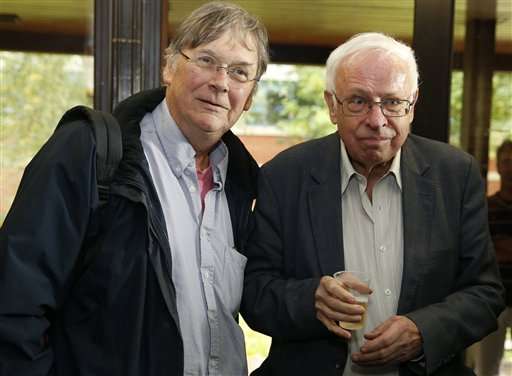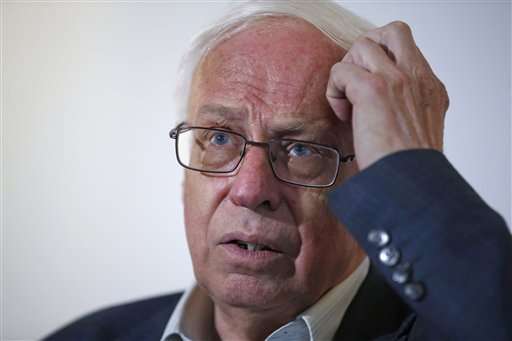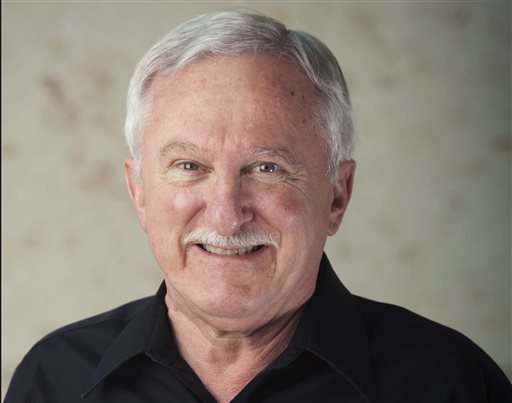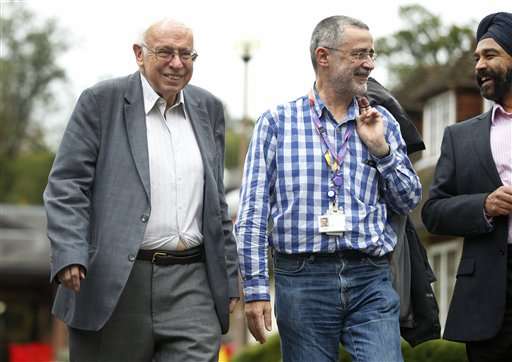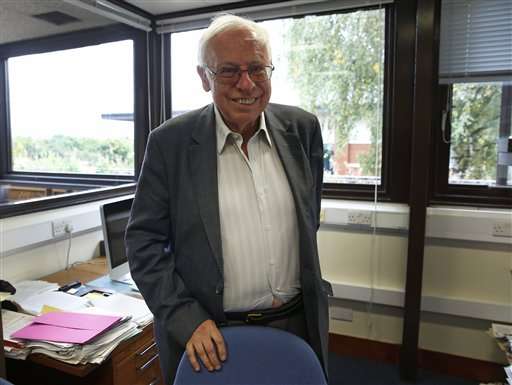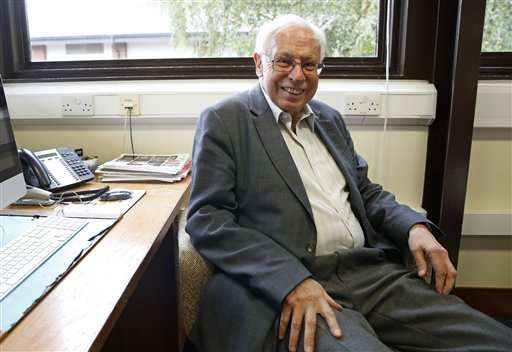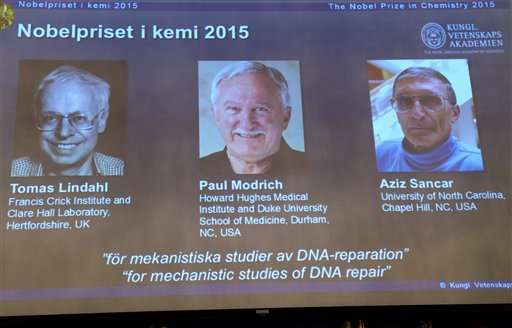Sweden's Tomas Lindahl, one of the joint winners of the 2015 Nobel Prize for Chemistry, has a drink of Champagne at the Francis Crick Institute in Potters Bar, north London, England, Wednesday, Oct. 7, 2015. Sweden's Tomas Lindahl, American Paul Modrich and U.S.-Turkish scientist Aziz Sancar won the Nobel Prize in chemistry on Wednesday for "mechanistic studies of DNA repair. (AP Photo/Alastair Grant)
Tomas Lindahl was eating his breakfast in England on Wednesday when the call came—ostensibly, from the Royal Swedish Academy of Sciences. It occurred to him that this might be a hoax, but then the caller started speaking Swedish.
It was no joke: Lindahl and two others had won the Nobel Prize in chemistry for pioneering studies into the way our bodies repair damage to DNA.
"Their work has provided fundamental knowledge of how a living cell functions" and is used in developing new cancer treatments, the academy said.
Lindahl, who is Swedish, was honored along with American Paul Modrich and U.S.-Turkish scientist Aziz Sancar for research done in the 1970s and '80s.
The men "really laid the foundations for the whole field" of DNA repair, said Alan Ashworth, president of the cancer center at the University of California, San Francisco. "These really are the fathers of the field."
Lindahl, 77, is an emeritus group leader at the Francis Crick Institute and Emeritus director of Cancer Research UK at Clare Hall Laboratory in Britain.
Modrich, 69, is an investigator at Howard Hughes Medical Institute and professor at Duke University School of Medicine in Durham, North Carolina.
Sancar, also 69, is a professor at the University of North Carolina School of Medicine in Chapel Hill, North Carolina. He is the second Turk to win a Nobel Prize, after novelist Orhan Pamuk was awarded the literature prize in 2006.
Sancar comes from a family of farmers with eight children; neither parent received an education but all the children are university graduates, Sancar told Haber Turk television.
Professor Sara Snogerup Linse, left explains why the laureates were awarded as Goran K. Hansson, centre and Claes Gustafsson, members of the Nobel Assembly sit, during a press conference at the Royal Swedish Academy in Stockholm, Wednesday, Oct. 7, 2015. Sweden's Tomas Lindahl, American Paul Modrich and U.S.-Turkish scientist Aziz Sancar won the Nobel Prize in chemistry on Wednesday for "mechanistic studies of DNA repair." (Fredrik Sandberg/ TT News Agency via AP)
He told The Associated Press that he thought the prize would be very important for Turkey.
"Young Turkish scientists need a role model showing that they can accomplish important contributions to science," he said.
Lindahl told reporters at his laboratory near London that the prize is "a great honor and a fantastic way of winding up my career."
Modrich, on vacation in New Hampshire, said he found out about his prize when a colleague emailed congratulations.
"I never quite put our work in this class, actually," Modrich told the AP. "It's nice to know other people put it in that class."
Sweden's Tomas Lindahl, one of the joint winners of the 2015 Nobel Prize for Chemistry, poses for the media at the Francis Crick Institute in Potters Bar, north London, England, Wednesday, Oct. 7, 2015. Sweden's Tomas Lindahl, American Paul Modrich and U.S.-Turkish scientist Aziz Sancar won the Nobel Prize in chemistry on Wednesday for "mechanistic studies of DNA repair.(AP Photo/Alastair Grant)
The prize is worth 8 million Swedish kronor (about $960,000).
Working separately, the laureates broke new ground by mapping and explaining several of the ways a cell repairs its DNA, the molecule that contains our genes. DNA sustains damage in multiple ways, such as when it is copied as cells divide or in response to chemicals or ultraviolet rays from the sun.
Sweden's Tomas Lindahl, one of the joint winners of the 2015 Nobel Prize for Chemistry, has a drink of Champagne at the Francis Crick Institute in Potters Bar, north London, England, Wednesday, Oct. 7, 2015. Sweden's Tomas Lindahl, American Paul Modrich and U.S.-Turkish scientist Aziz Sancar won the Nobel Prize in chemistry on Wednesday for "mechanistic studies of DNA repair. (AP Photo/Alastair Grant)
DNA was thought to be a stable until the 1970s, when Lindahl showed that it gets damaged so often that it seemed human life would be impossible. He realized that there must a repair mechanism, opening a new field of research, the academy said.
Working at Yale University, Sancar mapped the mechanism that cells use to repair UV-damaged DNA. Modrich showed how the cell corrects errors when DNA is replicated during cell division.
Sweden's Tomas Lindahl, one of the joint winners of the 2015 Nobel Prize for Chemistry, poses for the media at the Francis Crick Institute in Potters Bar, north London, England, Wednesday, Oct. 7, 2015. Sweden's Tomas Lindahl, American Paul Modrich and U.S.-Turkish scientist Aziz Sancar won the Nobel Prize in chemistry on Wednesday for "mechanistic studies of DNA repair. (AP Photo/Alastair Grant)
Some research into developing new cancer drugs is based on the idea of sabotaging the DNA repair that keeps cancer cells alive. One drug designed to do that is already used to treat advanced ovarian cancer, and many others are being studied, Ashworth said.
Rodney Rothstein, who studies DNA repair at the Columbia University Medical Center in New York, said the Nobel award shows the importance of basic research.
Sweden's Tomas Lindahl, one of the joint winners of the 2015 Nobel Prize for Chemistry, ponders a question during a press conference, at the Francis Crick Institute in Potters Bar, England, Wednesday, Oct. 7, 2015. Sweden's Tomas Lindahl, American Paul Modrich and U.S.-Turkish scientist Aziz Sancar won the Nobel Prize in chemistry on Wednesday for "mechanistic studies of DNA repair. (AP Photo/Alastair Grant)
The award will be handed out along with the other Nobel Prizes on Dec. 10, the anniversary of prize founder Alfred Nobel's death in 1896.
This year's medicine prize went to three scientists from Japan, the U.S. and China who discovered drugs to fight malaria and other tropical diseases. Japanese and Canadian scientists won the physics prize for discovering that tiny particles called neutrinos have mass.
The Nobel announcements continue with literature on Thursday, the Nobel Peace Prize on Friday and the economics award on Monday.
-
Sweden's Tomas Lindahl, right, one of the joint winners of the 2015 Nobel Prize for Chemistry, stands with the 2001 Nobel Prize in Physiology or Medicine, Tim Hunt, who congratulates him at the Francis Crick Institute in Potters Bar, north London, England, Wednesday, Oct. 7, 2015. Sweden's Tomas Lindahl, American Paul Modrich and U.S.-Turkish scientist Aziz Sancar won the Nobel Prize in chemistry on Wednesday for "mechanistic studies of DNA repair. (AP Photo/Alastair Grant)
-
Sweden's Tomas Lindahl, one of the joint winners of the 2015 Nobel Prize for Chemistry, ponders a question during a press conference, at the Francis Crick Institute in Potters Bar, England, Wednesday, Oct. 7, 2015. Sweden's Tomas Lindahl, American Paul Modrich and U.S.-Turkish scientist Aziz Sancar won the Nobel Prize in chemistry on Wednesday for "mechanistic studies of DNA repair. (AP Photo/Alastair Grant)
-
In this Wednesday, May 8, 2013, photo, provided by Howard Hughes Medical Institute, Paul Modrich poses for a photo at Howard Hughes Medical Institute's Janelia Farm Research Campus in Ashburn, Va. Modrich, an American, along with Swedish scientist Tomas Lindahl and U.S.-Turkish national Aziz Sancar won the Nobel Prize in chemistry, Wednesday, Oct. 7, 2015, for showing how cells repair damaged DNA, work that's inspired the development of new cancer treatments. (Kevin Wolf/Howard Hughes Medical Institute via AP)
-
Sweden's Tomas Lindahl, left, one of the joint winners of the 2015 Nobel Prize for Chemistry, smiles smiles as he arrives for a press conference, at the Francis Crick Institute in Potters Bar, England, Wednesday, Oct. 7, 2015. Sweden's Tomas Lindahl, American Paul Modrich and U.S.-Turkish scientist Aziz Sancar won the Nobel Prize in chemistry on Wednesday for "mechanistic studies of DNA repair. (AP Photo/Alastair Grant)
-
Sweden's Tomas Lindahl, one of the joint winners of the 2015 Nobel Prize for Chemistry, smiles before a press conference, at the Francis Crick Institute in Potters Bar, England, Wednesday, Oct. 7, 2015. Sweden's Tomas Lindahl, American Paul Modrich and U.S.-Turkish scientist Aziz Sancar won the Nobel Prize in chemistry on Wednesday for "mechanistic studies of DNA repair. (AP Photo/Alastair Grant)
-
Sweden's Tomas Lindahl, one of the joint winners of the 2015 Nobel Prize for Chemistry, smiles before a press conference, at the Francis Crick Institute in Potters Bar, England, Wednesday, Oct. 7, 2015. Sweden's Tomas Lindahl, American Paul Modrich and U.S.-Turkish scientist Aziz Sancar won the Nobel Prize in chemistry on Wednesday for "mechanistic studies of DNA repair. (AP Photo/Alastair Grant)
-
A view of the screen showing the winners of the 2015 Nobel Prize for Chemistry, during a press conference, in Stockholm, Wednesday, Oct. 7, 2015. Sweden's Tomas Lindahl, American Paul Modrich and U.S.-Turkish scientist Aziz Sancar won the Nobel Prize in chemistry on Wednesday for "mechanistic studies of DNA repair." (AP Photo)
Read The Latest: The Latest: Nobel chemistry prize winner Lindahl 'surprised'
Nobel Committee Press Release
The cells' toolbox for DNA repair
The Nobel Prize in Chemistry 2015 is awarded to Tomas Lindahl, Paul Modrich and Aziz Sancar for having mapped, at a molecular level, how cells repair damaged DNA and safeguard the genetic information. Their work has provided fundamental knowledge of how a living cell functions and is, for instance, used for the development of new cancer treatments.
Each day our DNA is damaged by UV radiation, free radicals and other carcinogenic substances, but even without such external attacks, a DNA molecule is inherently unstable. Thousands of spontaneous changes to a cell's genome occur on a daily basis. Furthermore, defects can also arise when DNA is copied during cell division, a process that occurs several million times every day in the human body.
The reason our genetic material does not disintegrate into complete chemical chaos is that a host of molecular systems continuously monitor and repair DNA. The Nobel Prize in Chemistry 2015 awards three pioneering scientists who have mapped how several of these repair systems function at a detailed molecular level.
In the early 1970s, scientists believed that DNA was an extremely stable molecule, but Tomas Lindahl demonstrated that DNA decays at a rate that ought to have made the development of life on Earth impossible. This insight led him to discover a molecular machinery, base excision repair, which constantly counteracts the collapse of our DNA.
Aziz Sancar has mapped nucleotide excision repair, the mechanism that cells use to repair UV damage to DNA. People born with defects in this repair system will develop skin cancer if they are exposed to sunlight. The cell also utilises nucleotide excision repair to correct defects caused by mutagenic substances, among other things.
Paul Modrich has demonstrated how the cell corrects errors that occur when DNA is replicated during cell division. This mechanism, mismatch repair, reduces the error frequency during DNA replication by about a thousandfold. Congenital defects in mismatch repair are known, for example, to cause a hereditary variant of colon cancer.
The Nobel Laureates in Chemistry 2015 have provided fundamental insights into how cells function, knowledge that can be used, for instance, in the development of new cancer treatments.
More information: www.nobelprize.org/nobel_prize … stry/laureates/2015/
© 2015 The Associated Press. All rights reserved.
